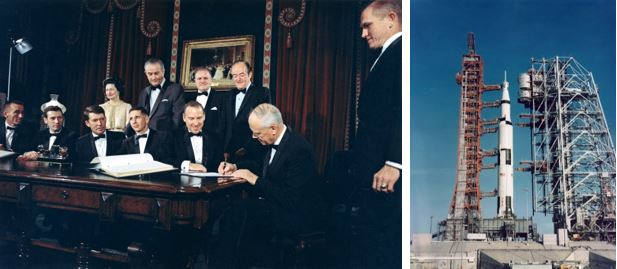The daring and audacious plan conceived only four months earlier and officially announced just the previous month was rapidly nearing realization. Humans were about to embark on a journey to orbit the Moon in a key step to meeting President John F. Kennedy’s goal of landing a man on the Moon and returning him safely to Earth before the end of the decade. The planning and preparations for the historic flight were nearly complete. The Apollo 7 crew had proven the space worthiness of the Apollo Command and Service Modules (CSM) in Earth orbit in October. Engineers had thoroughly tested the Saturn V rocket including loading it with propellant during the Countdown Demonstration Test (CDDT). Mission Control at the Manned Spacecraft Center (MSC), now the Johnson Space Center in Houston, and the Manned Space Flight Network, a series of tracking stations around the world used to monitor all aspects of the mission, were ready to support the flight. The US Navy was placing recovery forces, including the prime recovery ship the aircraft carrier USS Yorktown, into position to pick up the astronauts at the end of their mission. If all went well, in just a few days the giant Saturn V rocket, carrying a crew for the first time, would propel Apollo 8 astronauts Frank Borman, James A. Lovell, and William A. Anders on an unprecedented journey to lunar orbit and into the history books.

at right, Borman); also present were Apollo 7 astronauts (seated left to right) R. Walter Cunnigham, Donn F. Eiesele, and
Walter M. Schirra; legendary aviator Charles A. Lindbergh (seated at right, signing document); (standing, left to right)
First Lady Lady Bird Johnson, President Johnson, former NASA Administrator James E. Webb, and Vice President
Hubert H. Humphrey. Right: The Apollo 8 Saturn V on Launch Pad 39A during the countdown for its historic launch.
In preparation for the launch, the astronauts had arrived at KSC on Dec. 10, the day after attending a state dinner hosted by President Lyndon B. Johnson at the White House to honor NASA’s many accomplishments. The crew spent the last few days on Earth completing a few more runs in the Apollo mission simulator. On Dec. 11, they took part in the final phase of the CDDT, a full dress rehearsal of the launch countdown to T minus 8.9 seconds, the time when the five Saturn V first stage engines begin their ignition sequence. For this test, Borman, Lovell, and Anders wore their spacesuits and were strapped inside the Command Module, as on launch day. They found some time for relaxation, getting a little exercise, and decorating a Christmas tree since according to the flight plan, they would be in orbit around the Moon on Dec. 25. On Dec. 15, workers at KSC’s Launch Control Center began the long countdown for the flight, with an expected liftoff time of 7:51 AM EST on Dec. 21, 1968.

























